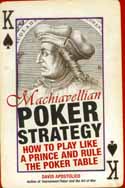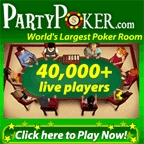
Machiavellian Poker Strategy
Poker and Net Present Value
Poker concepts can be learned from many other disciplines. A corporate lawyer by trade, I see numerous analogies between poker and business. In this column, I would like to share one that may shed David Apostolico is the author of 'Machiavellian Poker Strategy', and 'Tournament Poker and The Art of War,' and his latest title 'Poker Strategies for a Winning Edge in Business.' David's website is www.holdemradio.com/blog/ new light on a fundamental problem every tournament player faces.
David Apostolico is the author of 'Machiavellian Poker Strategy', and 'Tournament Poker and The Art of War,' and his latest title 'Poker Strategies for a Winning Edge in Business.' David's website is www.holdemradio.com/blog/ new light on a fundamental problem every tournament player faces.
Companies must make decisions based on the net present value of money. In simple terms, you would assign a discount rate (based on some market factor) to come up with the net present value of money you will spend or receive in the future. For instance, if you had a choice between spending $10,000 three years from now or $5000 up front for the same piece of equipment, you would do a net present value calculation to see which makes the most sense based on interest rates and opportunity costs. Where it gets more complicated is that every company will need to do a calculation specific to it.
For instance, say a company is faced with a choice of leasing equipment critical to its business for five years or purchasing the same equipment with 100% cash payment. The company knows that if it buys the equipment up front, it will take three years for it to break even (as opposed to leasing) on a net present value basis. In the remaining two years, it will pocket all the money it would otherwise have spent on a lease. Seems like an easy choice to buy, right? The answer is that it depends. For a well established cash rich company, it will be an easy choice to buy. For a cash poor start up company that may not even be around three years from now, the answer is probably not to buy. They would be better off leasing since they need the cash up front.
How is this relevant to a poker tournament? In poker as in business, things are not always as obvious as they appear to me. Let's look at a hypothetical daily poker tournament that starts with 100 people and each person begins with $1000 in chips. By the time half the people are eliminated, the average chip stack will be $2000 in chips. By the time, we are down to 25 people, then the average chip stack will be $4000. So, $1000 at the beginning of a tournament is the equivalent of $4000 when we are down to 25 people, right? Not necessarily. Tournaments are structured so that the blinds and antes increase at regular intervals. As a tournament progresses, luck often becomes a bigger part of the game at later levels. In addition, at the beginning of a poker tournament everyone has $1000. At the later stages, $4000 will be an average but many players will have far greater than this amount. The advantages of a large stack increase the deeper you are in a tournament.
In addition, in most tournaments the average stack is smaller in relation to the blinds as the tournament progresses. In our hypothetical tournament, the blinds may start out at $25-$25 meaning the starting stack is 40 times the big blind. By the time we are down to 25 people the blinds could easily be $300-$600 meaning the average stack of $4000 is less than seven times the amount of the big blind. Factor in antes and you can see that the average stack at this stage is not in great shape. There are likely to be a couple of players at your table who could easily have over $20,000 in chips. If one of those players has position on you, your opportunities are going to be limited.
So, in actuality that $4000 chip stack with 25 players remaining is really less powerful than the $1000 stack at the beginning of a tournament. Conventional wisdom is that if you can maintain an average stack, you are progressing nicely. In truth, you need to be maintaining a larger than average stack as the tournament progresses if you are going to win. The further you get into a tournament, the greater percentage above average you want to be.
Tournament payouts are weighted greatly to the top finishers. Your goal should be to get there and the way to get there is to turn average sized stacks into big stacks. Don't ever be satisfied with an average stack. While it's not time to panic, it is time to be creative and accumulate chips. Use those chips while they still have leverage and keep in mind that the net present value of an average stack is much greater at the beginning stages of a tournament.

